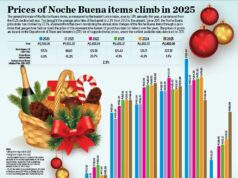January inflation could have eased from December, year ago — poll
By Melissa Luz T. Lopez, Reporter
INFLATION is expected to have eased last month from a year ago as record-low oil prices and spillover effects kept price increases of widely used goods benign, according to analysts polled by BusinessWorld late last week, with the rate expected to linger below the official target band targeted by the central bank.
A poll among 16 economists yielded an estimate median of 1.345% for January, well below the 2.4% rate seen a year ago and slower than the 1.5% pace recorded in December 2015.
The estimate also compares with the 0.8%-1.6% range expected by the Bangko Sentral ng Pilipinas (BSP) and the 1.2% forecast of Finance Undersecretary and chief economist Gil S. Beltran.
The economists polled all cited the continued dip in oil prices which allowed the rise in commodity prices to remain muted for the month.
Jose Mario I. Cuyegkeng of ING Bank N.V.-Manila said January inflation would likely be “more moderate than December”, citing lower retail costs of oil products, power rates, vegetables, and jeepney fares. “These should offset the still elevated meat prices and higher alcohol and tobacco product prices,” Mr. Cuyegkeng said, with a forecast rate of 1.1%. “We believe that the January moderation of inflation would be temporary and that the overall trend is still higher.”
In issuing the estimate on Thursday, BSP Governor Amando M. Tetangco, Jr. said lower oil prices offset upticks for food as well as tobacco and alcohol products following the yearly adjustment of excise tax under the “sin’ tax reform law passed in 2012.
The Philippine Statistics Authority is scheduled to report January inflation on Feb. 5.
Oil companies slashed pump prices anew early last week to reflect lower crude prices in the global market — marking eight straight weeks of rollbacks since December — as world benchmarks now trade at below $30 per barrel or nearly half than year-ago levels.
On Jan. 22, the Land Transportation and Franchising Regulatory Board rolled back the minimum fare for passenger jeepneys to P7 for the first four kilometers from P7.50.
The Manila Electric Co. (Meralco) also announced a fresh cut in power rates to P3.92 per kilowatt hour (kWh), the lowest rate since January 2010.
But other analysts cited the peso’s weakening against the dollar as an upside factor in inflation.
“Our inflation forecast remains at the high end of the BSP’s estimates at 1.6% for this month mainly due to a weakening peso and an uptick in core inflation, which may indicate underlying momentum in the rise in consumer prices,” Remrick E. Patagan, research director at the Institute for Development and Econometric Analysis, Inc. (IDEA), said by e-mail. “Moreover, the impact of unfavorable weather events near the turn of the year may spill over into this month. The declines in fuel prices and electricity rates, however, appear to be steeper than expected and, along with the recent reduction in transport fares, pose a downside risk to our forecast.”
Guian Angelo S. Dumalagan, market economist at the Land Bank of the Philippines, said “the peso’s depreciation against the US dollar also tempered the impact of declining energy prices by keeping import costs elevated” and that “[r]obust domestic demand likewise contributed to the gradual rise in consumer prices.”
Mr. Dumalagan, however, said declining oil and utility costs offset these factors to temper price increases.
The peso closed at P47.65 against the greenback on Friday, its best showing since a P47.995 finish on Wednesday that was a six-year low. The local currency is now 1.3% weaker than its P47.06-per-dollar finish in 2015.
Though most of the analysts polled gave below-2% inflation estimates, many shared the view that inflation will pick up in the months ahead to eventually settle within the central bank’s 2%-4% target band.
“We expect inflation to moderate on a year-on-year basis. Inflation is rather contained and within the central bank’s 2-4% target,” said Trinh D. Nguyen, senior economist at Natixis.
The stronger-than-expected dry spell projected to last as late as July would also push prices further up, another analyst pointed out. “For the coming months, we see inflation continuing to pick up especially in light of the dry season exacerbated by El Niño,” IDEA’s Mr. Patagan said, even as he noted downward pressures should world crude prices remain depressed.
As of its Dec. 17 policy meeting, the BSP expected inflation to average 2.4% this year. Mr. Tetangco earlier said that inflation is expected to move closer to the midpoint of the target band.
Tempered inflation should allow the central bank to keep monetary policy steady in its upcoming review on Feb. 11. “We expect commodity prices to remain weak for the time being and thus there is no pressure for the BSP to change its policy stance,” Ildemarc C. Bautista, assistant vice-president and head of research at Metropolitan Bank & Trust Co., said by e-mail.
The BSP’s Monetary Board maintained its policy for the 10th time in a row during its Dec. 17 meeting even as the US Fed finally raised interest rates for the first time in nearly a decade.
“Though headline inflation trended to lows last year, we have seen a recovery since. Moreover, core CPI remained relative stable and, therefore, the inflation rate is unlikely to be of concern in the upcoming monetary policy decision,” said Jingyi Pan, economist at the Singapore-based market research firm Forecast Pte. Ltd.




